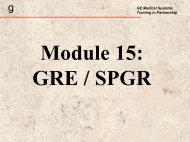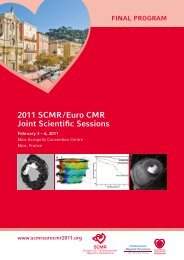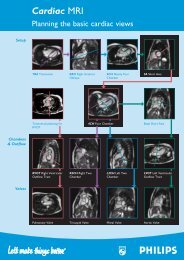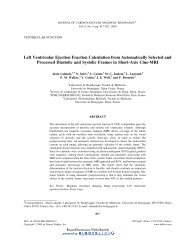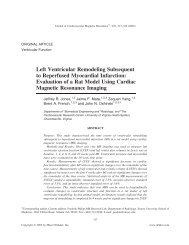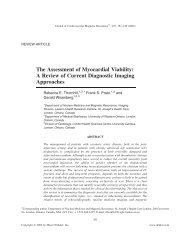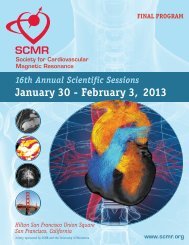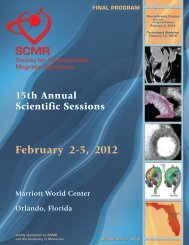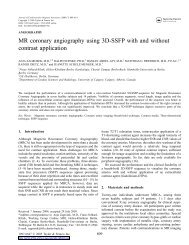Accurate and Reproducible Mitral Valvular Blood Flow Measurement
Accurate and Reproducible Mitral Valvular Blood Flow Measurement
Accurate and Reproducible Mitral Valvular Blood Flow Measurement
You also want an ePaper? Increase the reach of your titles
YUMPU automatically turns print PDFs into web optimized ePapers that Google loves.
774 Westenberg et al.<br />
DISCUSSION<br />
Kayser et al. (1997) demonstrated that myocardial<br />
motion correction is m<strong>and</strong>atory for obtaining accurate<br />
transvalvular flow values with single-slice 1-directional<br />
velocity-encoded MRI. The motion of the myocardium<br />
due to the contraction <strong>and</strong> relaxation in the same<br />
direction of the flow through the MV (i.e., the throughplane<br />
motion for 1-dir MV flow) will result in an<br />
offset in the velocities measured at the location of the<br />
MV annulus. By measuring the through-plane velocity<br />
of the myocardium in a region of interest, positioned<br />
inside the myocardial wall <strong>and</strong> subtracting this velocity<br />
from the velocities measured at the MV-annulus,<br />
motion correction is performed. This motion correction<br />
is not sufficient to guarantee that the acquired flow<br />
equals the transvalvular flow, though. The single acquisition<br />
plane is positioned at the location of the MV at<br />
end-systole. Because this plane has a fixed position<br />
<strong>and</strong> is not adapted to the cardiac motion, the acquisition<br />
is performed inside the LV during most part of<br />
the cardiac cycle. In this study, the MV-flow volume<br />
measured conform the method of Kayser et al. (i.e.,<br />
1-dir MV-flow volume) was compared to the flow<br />
volume measured at the aorta. No statistically significant<br />
correlation was found. The 1-dir MV-flow volume<br />
showed a statistically significant overestimation compared<br />
to the AO-flow volume. This illustrates that the<br />
1-dir MV-flow method, although readily applied in<br />
clinical studies (Kroft <strong>and</strong> de Roos, 1999; Rebergen<br />
et al., 1996), is not recommended for accurate transvalvular<br />
MV-flow measurement.<br />
Kozerke et al. (1999) introduced a new acquisition<br />
method for a single-slice flow measurement at the aortic<br />
valve, with the acquisition plane adapted to the heart<br />
motion (STrack). The acquisition plane follows the basal<br />
level during the cardiac cycle, <strong>and</strong> after myocardial<br />
through-plane motion correction, this results in an<br />
accurate transvalvular flow measurement. A disadvantage<br />
of their method is the necessity of prospective<br />
triggering, resulting in an incomplete acquisition of<br />
the cardiac cycle. The final part of the RR-interval<br />
cannot be acquired <strong>and</strong> is ignored. For MV-flow measurement,<br />
acquisition of the complete diastole is m<strong>and</strong>atory.<br />
For regurgitation studies, the complete systole<br />
<strong>and</strong> diastole need to be acquired. When studying transvalvular<br />
MV flow, the use of retrospective gating is<br />
preferred over prospective triggering. Another disadvantage<br />
of the method proposed by Kozerke et al.<br />
(1999) is that the acquisition software is not available<br />
on all commercially available MRI scanners.<br />
In our study, a new method was introduced to<br />
assess the true transvalvular MV-flow. No dedicated<br />
scanning software is required to apply this protocol.<br />
The complete velocity vector field of the blood flow<br />
inside the LV, acquired with 3-directional velocityencoded<br />
MRI using retrospective gating, was obtained<br />
<strong>and</strong> reconstructed to 30 time phases covering one<br />
average complete cardiac cycle. Retrospectively, the<br />
position of the MV in this velocity vector field was<br />
indicated manually for each time phase, <strong>and</strong> from this,<br />
the flow through the MV was acquired. The velocities<br />
in the MV-plane were corrected for the through-plane<br />
motion of the myocardium in the apical-basal direction,<br />
perpendicular to the MV-plane itself. Integrating the<br />
velocities over the area of the MV annulus (indicated<br />
manually) resulted in the MV flow.<br />
Because of time limitations, it is impossible to<br />
acquire the complete transvalvular flow with slices<br />
oriented parallel to the long axis. Therefore, the flow is<br />
acquired with a radial stack of six acquisition planes.<br />
The axis of the radial stack is positioned in the center of<br />
the mitral annulus. This means that in the blood flow in<br />
the center of the mitral annulus will be densely sampled.<br />
In the outer part of the mitral annulus, the flow is not<br />
sampled in all the parts of the mitral annulus. The<br />
acquisition voxels in the plane of the mitral annulus<br />
have dimensions of 2.89 mm8 mm. For a circularshaped<br />
mitral annulus with a 40-mm diameter, 62% of<br />
the area of the annulus will be covered with acquisition<br />
voxels. In reality, the area of the annulus will not be<br />
circular shaped <strong>and</strong> therefore, smaller. The nonsampled<br />
parts of flow through the annulus will be reconstructed<br />
by triangular interpolation.<br />
This method was applied to obtain the MV-flow<br />
volume in 10 healthy volunteers. The 3-dir MV flow<br />
showed very good correlation with the AO flow. The<br />
differences between the flow volumes from both<br />
methods were very small <strong>and</strong> not statistically significant.<br />
When comparing the MV-flow volume to the AO<br />
flow volume, the flow to the coronaries has to be taken<br />
into account. The AO flow was acquired at a level<br />
distal to the branches of the coronaries. This implies<br />
that the AO-flow volume measured at this location will<br />
be smaller than the MV-flow volume. In our study, this<br />
small systematic difference was not detectable. The<br />
contribution of the flow to the coronaries, only 0.5% of<br />
the cardiac output (Mymin <strong>and</strong> Sharma, 1974), was too<br />
low to be detected by this method.<br />
A high reproducibility for flow quantification with<br />
3-dir MV flow was found. The manual interaction during<br />
image analysis was performed twice by one observer<br />
with an interanalysis time >1 week. Excellent correlation<br />
between both analyses was found <strong>and</strong> the differences<br />
between the analyses were small <strong>and</strong> not statistically<br />
significant. The interobserver study showed similar<br />
results, i.e., very high correlation between observers<br />
<strong>and</strong> small, not statistically significant differences.



